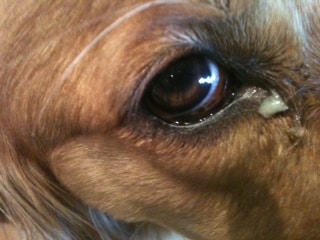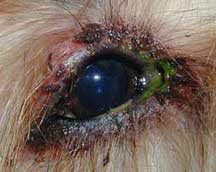
Dog eye boogers just like any other form of eye discharge is a common problem for dogs. It appears to be more pronounced in some dogs. While this is not always a medical condition, it may be indication allergies and eye infections. Eye boogers are not a problem unless they become excessive or accompanied by other signs such as rubbing of the eyes and sneezing. Why do dogs get eye boogers? Are there effective ways of getting rid of eye boogers in dogs? Here are answers to this and more on dog eye boogers.
Contents
- Eye Boogers in Dogs
- Why Does My Dog Have Eye Boogers?
- What Causes Dog Eye Boogers?
- Green Eye Boogers in Dogs
- Excessive Eye Boogers in Dogs
- How to Get Rid of Dog Eye Boogers
- Home Treatments to Help Remove Dog Eye Boogers
- Salt and Warm Water to Clean Crusty Eyes
- Chamomile Tea
- What to Do When Your Dog Has Eye Boogers
Eye Boogers in Dogs
What are dog eye boogers? Eye boogers are those crusties you find stuck on the side of your eyes every morning you wake up. This crust made up of mucus, oil, skin cells and dust particles is naturally discharged as a thin mucus from the dog’s eyes. Eye boogers are also commonly known as eye gunk or shnooters.

It’s normal for human beings to wipe out eye gunk in the corner of their eyes first thing when they wake up in the morning. Eye boogers in dogs can accumulate and cling to the lashes making their vision less clear.
How do eye boogers form? What causes eye boogers? It is common knowledge that dog eye boogers are made from an accumulation of dried up tears. According to nbcnews.com, tears are made up of water, protein, oils and a mucus layer that coats the surface of the eyes. This layer serves to moisten the surface of the eye and protect it from bacterial and viral invasion. Your dog’s eyes pick up dust, pollen, and dirt throughout the day.
The production of tears is also a physiological function where the eyes attempt to clear out debris, moisten and supply nutrients to all parts of the eyes. When tears are minimally or excessively produced, they may collect at the corner of the eye, precipitate and dry up to form crusties known as boogers. Consistency may be watery, gooey or crusty depending on the cause of the discharge.
Why Does My Dog Have Eye Boogers?
Why Do Dogs Get Eye Boogers? Once the eyes are closed and shut at night, dirt is not continually washed out by tears. Dog eye boogers tend to be more apparent in the morning as the gunk accumulates overnight while the eyes are shut and not blinking. They collect up at the corner of the eyes, underneath or sometimes on the eyeball.

There are several things that are worth checking out once you notice your dog has eye boogers:
Are there any masses inside or near the eye? Injuries to the eye invariably result in irritation, tearing and different types of discharges. You can simply check this at home by gently flushing the eye with saline solution. This will help clear the eye of any foreign material and give you a better view of the extent of the problem.
Is your dog rubbing or scratching the affected eye? Persistent rubbing or scratching may subject the eye to repeated trauma. Consult your vet immediately if the irritation persists.
What breed is your dog? Are some breeds more prone to dog eye boogers?
It appears that some dog breed seems to be more prone to eye boogers than others. Dogs with naturally bulging eyes are more likely to have eye problems such as eye discharge compared to other breeds. Dogs with bulging eyes have a narrower drainage angle and increased intraocular pressure which is a major contributing factor to glaucoma. Bulging eyes are more exposed to the foreign material, trauma and environmental conditions that cause dryness.
Being knowledgeable about this factors concerning your dog’s eyes will put in a better place to be able to act swiftly once there is a slight concern for the health of your dog’s eyes. Breeds prone to eye boogers include those with flat faces like Boxer dogs, bloodhounds, cocker spaniels, beagles, and bulldogs.
Hair growth around your dog’s eyes can lead to accumulation of tears around the eyes. Hair wicks away tears from the eye to the face. Dried tears could show up in the morning as crusty eye boogers.
Previous eye infections could lead to eye boogers. How does this happen you may ask? Eye infections or damage can cause scarring that may block tear drainage. Infections such as conjunctivitis and other viral infections can cause inflammation of the thin eye membrane.
What Causes Dog Eye Boogers?
What causes dogs to have eye boogers? Having your dog with eye boogers in the morning is a very normal occurrence save for when there is a change in color and amount. Excessive eye boogers may be an indication of eye infections or some other eye problem that needs to be checked out. Here are some of the most common causes of eye boogers in dogs:
- Obstruction of tear ducts
- Inversion of the eyelids also known as entropion
- Displacement of the lens
- Trauma or any other kind of injury to the eye
- Corneal ulcers
- Cherry eye
- Glaucoma
- Dry eyes
- Conjunctivitis
- Excessive tear production
Note that it is also possible to have other problems that are unrelated to the eyes causing excessive production of eye boogers. Dog allergies, bacterial or viral infections are just some of the common systemic problems that may cause eye discharge in dogs.
Green Eye Boogers in Dogs
My dog had green eye boogers, could it be a bacterial infection? Dog eye boogers are very normal save for when they become excessive or change color to green or yellow. Yellow or green eye boogers could be a sign of a bacterial infection that needs to be checked out by your vet. Other symptoms may include, eyelashes that are stuck together, red or pink eye whites, puffiness, and irritation.

Doogie eye boogers usually clear on their own but if this material is greenish and recurs many times with surrounding tissue irritation, pain, redness, and irritation, consult a vet for further attention and medication if necessary.
Excessive Eye Boogers in Dogs
According to petplace.com, eye discharge is mostly an indication of eye irritation and pain. Excessive eye boogers is a not sure diagnosis of a specific disorder. It simply represents the response of the eye to irritation, injury and inability to effectively drain tears. The exact cause can only be determined by careful examination and diagnostic tests which can only be done by the eye vet.
While a small amount of eye discharge is normal, the best thing you can do is observe for any changes in color, frequency and amount. A small change is worth being checked out.
Treatment depends on the exact cause of the problem. Since there are many causes of dog eye boogers, it is essential to get a proper diagnosis and provide appropriate treatment.
How to Get Rid of Dog Eye Boogers
Eye boogers will usually clear on their own. While there are things you can easily do at home to get rid of eye boogers in dogs, it is very important to know when to seek further attention. If your dog constantly has a runny nose, itchy eyes, and discharge, consult your vet immediately. Dog eye boogers are a natural way of the eyes to wash out dirt and debris. It is not possible to prevent them.

If your dog has excessive eye boogers that are thick and teary eyes that constantly wet the hair around the eyes, you may need to check with the vet to rule out allergies, eye infections, dry eye or other eye conditions that need to be checked out. It is also important to note that treatment of dog eye boogers depends on the underlying factor. Before any treatments, it is important to examine the eye thoroughly. Check for;
What is normal?
- Clear bright eyes with a white eyeball
- The boogers are white, milky or pale yellow in color. Sometimes they may be black
- If found in the corners or underneath the eyes
What is not normal?
- Bloodshot eyes
- Bad Odor
- Discharge over the eyelids impeding movement of the eyes
- Visible third eyelid
- Cloudiness or change in eye color
- Unequal pupil sizes
Home Treatments to Help Remove Dog Eye Boogers
Home treatments are the easiest and safest measures you can take to at least cleanout eye gunk and increase visibility. Removing crusties may make it easier for you to examine other parts of the eyes.
Salt and Warm Water to Clean Crusty Eyes
While this sounds like a simple remedy, it is the most popular and effective home treatment for eye boogers on dogs. It can be used to cure different eye infections by cleaning out the discharge. Gently splash sterile saline solution into your dog’s eyes and use a clean cotton ball to clean the eye outwards. Alternatively, you can dip a clean cotton ball in the warm saline solution and wipe to remove the crust and debris on the outside of your dog’s eyes daily to prevent bacterial infections.
Chamomile Tea
Chamomile tea is considered to be an antiseptic that can serve to prevent all kinds of eye infections in dogs.
- Steep a chamomile tea bag in hot water and allow it to cool. Put the chamomile tea in a small squirt bottle and use to gently splash the dog’s eyes twice a day for a week
- You can alternatively use a used chamomile tea bad to wipe on your dog’s closed eyelids to relieve pain and clean crusties on the edges of eyes
NB: Always wipe your pooch’s eye outward from the corner of the eye. Be careful not to touch the eyeball or scratch the cornea.
What to Do When Your Dog Has Eye Boogers
My Dog Has Eye Boogers, what should I do? Other than the simple remedies given above, it is not recommended to treat abnormal eye discharge at home. There are however things you can do to make the process of diagnosis and treatment easier;
Tips on how to clean eye boogers on dogs:
- Wash your hands frequently especially if you handling other dogs with eye infections
- Avoid touching the eye as much as possible. Picking at your dog’s eyes may cause more discomfort and may lead to injury or infection.
- Trim the hair around the eyes to prevent collection and accumulation of more eye discharge. Have a groomer do this other than doing it on your own.
- Do not use harsh soaps and irritants for grooming. Protect your dog’s eyes while bathing him and applying ointments or flea control sprays.
- Watch out for signs such as pawing and rubbing which will alert you to possible eye problems
- Be in the know of common dog eye problems
- Do not administer human eye prescription medicines or over the counter eye drops